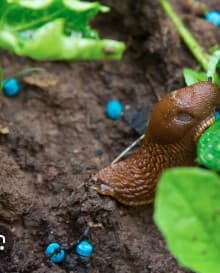Snail bait poisoning is a serious concern for dog owners, as it can have devastating effects on our furry companions AND THERE IS NO ANTIDOTE!
In this article, we will explore what snail bait poisoning is, how dogs get exposed to it, the symptoms to watch out for, the diagnostic procedures and treatment options available, and most importantly, how to prevent it from happening in the first place.
Snail Bait Poisoning In Dogs: Table of Contents
What is Snail Bait Poisoning?
Snail bait poisoning occurs when dogs ingest or come into contact with snail bait products that contain toxic substances (metaldehyde, iron phosphate, or methiocarb). These substances are typically designed to kill snails, slugs, and other pests in gardens and outdoor areas.
What Does Snail Bait Look Like?
Snail bait looks like dog kibble, but it can be in different colors.

Symptoms of Snail Bait Poisoning in Dogs
The symptoms can vary depending on the severity of the poisoning and the specific toxic substance involved.
How long after eating snail bait do dogs get sick?
Early warning signs of snail bait poisoning may include:
- excessive drooling,
- vomiting,
- diarrhea,
- tremors, and restlessness
- panting
These symptoms can appear within a few minutes – a few hours of exposure.
Progression of Symptoms
As the poisoning progresses, dogs may display more severe symptoms such as:
- muscle rigidity,
- increased heart rate,
- difficulty breathing,
- seizures, and even coma
- High fever.
Seek immediate veterinary care if any of these symptoms occur.
Diagnosis of Snail Bait Poisoning
Diagnosing snail bait poisoning requires a thorough evaluation of the dog’s symptoms, exposure history, and physical examination. Prompt and accurate diagnosis is crucial for initiating appropriate treatment.
Veterinarians may conduct blood tests, urine analysis, and imaging studies like X-rays to assess the dog’s overall health, identify the toxic substances involved, and determine the severity of the poisoning.
Treatment for snail bait poisoning in dogs
The treatment approach for snail bait poisoning will depend on the dog’s condition and the specific toxic substance.
It may include inducing vomiting, administering activated charcoal to prevent further absorption, intravenous fluids for hydration, and supportive care to manage symptoms.
The prognosis for snail bait poisoning can vary, depending on factors such as the amount of exposure, the toxic substance involved, and the timeliness of treatment.
Prevention of Snail Bait Poisoning in Dogs
Preventing snail bait poisoning is key to keeping our furry friends safe. By implementing a few simple measures, we can greatly reduce the risk of exposure.
Safe Alternatives to Snail Bait
Use safe alternatives to snail bait products that are specifically labeled as pet-friendly. These products are formulated to be non-toxic to pets while effectively repelling pests. Additionally, consider natural pest control methods, such as creating barriers or using organic repellents.
Tips for Dog Owners
Always supervise dogs when they are outdoors, especially in areas where snail bait may be present.
Regularly inspect your garden or yard for signs of snail bait products and promptly remove them.
Train your dog to avoid consuming or contacting unknown substances and ensure they have access to a safe and secure environment.
What happens if a dog eats snail bait?
When a dog ingests or comes into contact with snail bait, the toxic substances can quickly enter their bloodstream and affect various organs and systems in their body.
The severity of the poisoning depends on factors such as the amount of bait consumed, the size and age of the dog, and the type of toxic chemical involved.
Metaldehyde, one of the common ingredients found in snail bait, is a powerful neurotoxin. It affects the central nervous system of dogs, leading to symptoms such as tremors, seizures, muscle rigidity, and increased heart rate. In severe cases, it can even cause respiratory failure and death.
Iron phosphate, another ingredient used in some snail baits, is considered less toxic than metaldehyde. However, it can still cause gastrointestinal upset in dogs, leading to symptoms like vomiting, diarrhea, and abdominal pain. In rare cases, iron phosphate poisoning can also result in liver damage.
Methiocarb, although less commonly used in snail bait products, is highly toxic to dogs. It affects the nervous system and can cause symptoms such as excessive drooling, muscle weakness, difficulty breathing, and even coma.
How Dogs Get Exposed to Snail Bait Poisoning
One common scenario is when dogs accidentally ingest snail bait pellets or granules left in the garden or yard.
Dogs are known for their curious nature, and they may mistake these products for food or toys. This is especially true for puppies who are still exploring their surroundings and are more likely to put unfamiliar objects in their mouths.
Another common scenario is when dogs come into direct contact with liquid sprays or granules that have been applied to plants or outdoor surfaces.
The toxic chemicals can be absorbed through the skin or ingested when the dog licks their paws or fur. This can happen when dogs play or roll around in areas where snail bait has been recently applied.
It’s important to note that snail bait poisoning can also occur indirectly. For example, if a dog encounters a snail or slug that has consumed the bait, it can become poisoned by ingesting the contaminated mollusk. This highlights the potential dangers of using snail bait in areas accessible to pets.
Common Types of Snail Bait
There are various types of snail bait available in the market, and it’s important for dog owners to be aware of them. Some common types include pellet formulations, liquid sprays, and granules. Each formulation may contain different active ingredients and have varying degrees of toxicity.
Pellet formulations are small, granular pellets that are typically scattered around the garden or outdoor area. Dogs may mistake these pellets for food or treats and accidentally ingest them. Liquid sprays, on the other hand, are sprayed directly onto plants and can be easily licked off by curious dogs. Granules are larger particles that can be spread on the ground or mixed into the soil, posing a risk of ingestion if dogs come into contact with them.
It’s important for dog owners to carefully read and follow the instructions on snail bait products, as well as keep them out of reach of their pets. Additionally, it’s recommended to use pet-safe alternatives or natural methods to control snails and slugs in garden areas to prevent accidental poisoning.
If a dog shows any symptoms of snail bait poisoning, such as vomiting, tremors, or difficulty breathing, it’s crucial to seek immediate veterinary attention. Prompt treatment can greatly increase the chances of a positive outcome and minimize the potential long-term effects of snail bait poisoning.
Risk Factors for Dogs
Certain factors can increase a dog’s risk of snail bait poisoning. Factors such as age, breed, size, and health condition can play a role in how susceptible a dog is to the toxic effects of these products.
Puppies and older dogs may be more vulnerable due to their weaker immune systems and less developed ability to metabolize toxins.
Collies or Australian Shepherds may have a higher sensitivity to snail bait chemicals.
Dogs with a habit of scavenging or exploring gardens and outdoor spaces are more likely to encounter snail bait. These dogs may have a natural inclination to investigate their surroundings, making them more susceptible to accidental exposure.
Even well-trained dogs can be at risk if they are not closely supervised or if snail bait is used in areas where they have access. Vigilance and proactive measures are key to ensuring the safety and well-being of our canine companions.
My Senior Paws is a participant in the Amazon Services LLC Associates Program, an affiliate advertising program designed to provide a means for sites to earn advertising fees by advertising and linking to Amazon.com. We also participate in other affiliate programs which compensate us for referring traffic.




